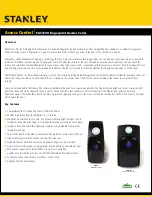
30
EXDUL-592E / EXDUL-592S
© 2019 by Messcomp Datentechnik GmbH
DV02
30
EXDUL-592E / EXDUL-592S
© 2019 by Messcomp Datentechnik GmbH
EV03
wasco
®
wasco
®
In diesem Beispiel sollen drei Kanäle abgetastet werden (z.B. AINU1+,
AINU2+, AINU3+). Diese Kanäle werden mit dem Befehl übergeben und
das Modul beginnt mit den 32 Messungen des ersten Kanals (hier AINU1+).
Sobald die Messungen des ersten Kanals abgeschlossen sind, wird mit der
Abtastung des 2. Kanals begonnen. Wurden alle Kanäle fertig abgetastet,
(hier nach 960µs = Kanalanzahl*32*10µs), werden Offset und Gain-Fehler
abgeglichen und die Spannungen in µV übergeben.
6.3.4 Mehrfachmessung
Beim Messmodus Mehrfachmessung können bis zu 8 Kanäle mehrfach
(bis zu 65535 mal) abgetastet werden. Dabei werden bei der Übergabe des
Befehls neben der gewünschten Abtastrate (1 - 100kS/s) die gewünschten
Kanäle mit dem jeweiligen Spannungs-/Strombereich übergeben. Nach
Erhalt des Befehls führt das Modul die Messungen durch und speichert
abgeglichenen Werte in µV und/oder µA in das FIFO ab. Aus dem FIFO
können diese Werte jederzeit abgeholt werden. Dabei ist darauf zu achten,
dass das FIFO nicht überläuft. Es wird empfohlen, diesen Messmodus bei
einer Messanzahl über 10000 Messungen nur mit einer Abtastrate von bis
zu 20kS/s zu betreiben. Zudem darf in diesem Zeitraum kein EXDUL-Info-
Register beschrieben werden.
6.3.5 Dauermessung
Beim Messmodus Dauermessung können bis zu 8 Kanäle mit beliebigem
Messbereich und mit bis zu 100kS/s im Dauerbetrieb abgetastet werden.
Hierfür gibt es einen Start- und einen Stop-Befehl. Die abgeglichenen
Messwerte werden in µV und/oder µA in ein FIFO geschrieben und können
von dort jederzeit abgeholt werden. Dabei ist darauf zu achten, dass das
FIFO nicht überläuft. Es wird empfohlen, diesen Messmodus nur mit einer
Abtastrate von bis zu 20kS/s zu betreiben. Zudem darf in diesem Zeitraum
kein EXDUL-Info-Register beschrieben werden.
In this example, three channels are to be sampled (e.g.AINU1+, AINU2+,
AINU3+).These channels are transferred along with the command, and the
module starts running 32 measurements of the first channel (here AINU1+).
As soon as the measurements of the first channel have been completed, the
sampling of the second channel is started. Once all of the channels have
been sampled (duration here 960µs = number of channels*32*10µs), offset
and gain errors are calibrated and the voltages in µV are transferred.
6.3.4 Multiple measurement
In the multiple measurement mode, up to 8 channels can be sampled
several times (up to 65,535 times). Along with the command, the desired
sampling rate (1 - 100kS/s) and the desired channels with the respective
voltage range are transmitted. Upon receiving the command, the module
performs the measurements and stores the calibrated values in µV into
the FIFO. These values can be retrieved from the FIFO at any time. It is
important to ensure that the FIFO does not overflow. It is recommended to
operate this measurement mode with a sampling rate of up to 20kS/s only
at a measurement count of more than 10,000 measurements. Additionally,
you must not write to any EXDUL information register during this period.
6.3.5 Continuous measurement
In the continuous measurement mode, up to 8 channels with any measu-
ring range and up to 100kS/s can be sampled in continuous operation. For
this purpose, there is a start and a stop command. The calibrated mea-
sured values in µV are written to the FIFO and can be retrieved from there
at any time. It is important to ensure that the FIFO does not overflow. It is
recommended to operate this measurement mode with a sampling rate
of up to 20kS/s only. Additionally, you must not write to any EXDUL infor-
mation register during this period.
















































